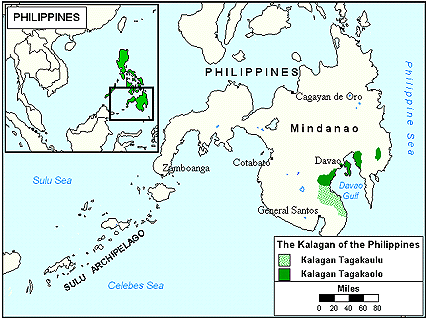|
|
Prayer Profile
The Tagakaulu of the Philippines
![[IMAGE]](../images5/0824.jpg) The Kalagan live on the island of Mindanao in the southern Philippines. They are located in an area between the interior uplands and the western coast of the Davao Gulf. The Kalagan are thought to be one of various groups of lowland Filipinos who came to the islands from Asia's southwestern mainland several thousand years ago. Their lifestyle and culture are very similar to that of the Magindanaw.
The Kalagan live on the island of Mindanao in the southern Philippines. They are located in an area between the interior uplands and the western coast of the Davao Gulf. The Kalagan are thought to be one of various groups of lowland Filipinos who came to the islands from Asia's southwestern mainland several thousand years ago. Their lifestyle and culture are very similar to that of the Magindanaw.
With the arrival of Islam in the 1500's, the Kalagan split into two separate groups—the Tagakaulu Kalagan and the Tagakaolo Kalagan. The Tagakaulu Kalagan speak Tagakaolo, which is closely related to a number of other languages spoken in the region.
While some of the Tagakaulu Kalagan receive wages for labor, others work as farmers. Maize is the major crop grown and is harvested two or three times a year. The coastal Kalagan are also fishermen; others work as laborers on plantations.
What Are Their Lives Like?
The Tagakaulu Kalagan are self-sufficient farmers, producing nearly all of their own food. Wet-rice is grown in the lowlands, and dry-rice and corn are farmed in the upland areas. Yams and sweet potatoes are also staple crops. Vegetables such as tomatoes, squash, and beans are grown; coconuts abound; and many kinds of fruit are available. Goats are raised for meat, and chickens are raised for both eggs and meat. In addition to farming, the Tagakaulu Kalagan catch fish and obtain wild foods and other various materials from the marshes around them.
Those of highest rank in their society do not perform manual labor. Among the rest of the population, male/female division of labor is not very pronounced. Generally, men do the plowing, tilling, and other heavy farm work. The women do most of the domestic work, often assisted by their older children.
Tagakaulu Kalagan art is confined mostly to weaving, basket making, and producing certain ornaments. Personal adornment in the form of bright clothing, beaded jewelry, and other accessories is distinctive and colorful. On special occasions, graceful dances are performed to the rhythmic music of gongs and other instruments.
The Tagakaulu Kalagan social structure is unusual because it is modified by a system of social rank, certain rules of descent, and distinctive marriage patterns. For most purposes, social rank is less important than blood ties. Higher-ranking families maintain elaborate genealogies to prove their claims of descent.
There is a strong preference for marriage between related families, especially marriage to second cousins. After marriage, the couple usually resides in the husband's community. Today, however, many young couples form their own independent households.
What Are Their Beliefs?
The Tagakaulu Kalagan were not introduced to Islam until Muslim missionaries arrived in the area during the 1500's. About half of the entire group of Kalagan came under Islamic influence at that time, and the group divided. Most of the Tagakaolo Kalagan became Muslims; however, the majority of the Tagakaulu Kalagan remained animists (believe that non-human objects have spirits). Today, many of them are still ethnic religionists, believing in the traditions and religions of their forefathers. They continue to believe in a variety of "environmental spirits." Many tales are also told of magic, sorcery, and supernatural beings.
What Are Their Needs?
Although seven missions agencies are currently working among the Tagakaulu Kalagan, response to the Gospel has been minimal. Today, only 4% of them have become Christians. Only portions of the Bible have been translated into their language, and there are no Christian broadcasts currently being aired in their language. Intercession and evangelistic tools are desperately needed to free the Tagakaulu Kalagan from the bondage of their religious traditions.
Prayer Points
- Ask the Holy Spirit to grant wisdom, favor, and unity to the seven missions agencies that are targeting the Tagakaulu Kalagan.
- Pray that the Jesus film will soon be produced in the Tagakaolo language.
- Ask the Lord to raise up qualified linguists to complete the translation of the Bible into Tagakaolo.
- Pray that God will reveal Himself to the Tagakaulu Kalagan through dreams and visions.
- Pray that God will give the Tagakaulu Kalagan believers boldness to share Christ with their own people.
- Take authority over the spiritual principalities and powers that are keeping the Tagakaulu Kalagan bound.
- Ask God to raise up prayer teams who will begin breaking up the soil through worship and intercession.
- Ask the Lord to bring forth a triumphant Tagakaulu Kalagan church for the glory of His name!

See also the following related group:
The Kalagan of the Philippines.
Statistics
Latest estimates from the World Evangelization Research Center.
THE PEOPLE
- People name: Tagakaulu Kalagan
- Country: Philippines
- Their language: Tagakaolo
- Population:
- Largest religion:
- Christians: 4%
- Church members: 2,403
- Scriptures in their own language: Portions
- Jesus Film in their own language: None
- Christian broadcasts in their own language: None
- Mission agencies working among this people: 7
- Persons who have heard the Gospel: 20,400 (34%)
- Persons who have never heard the Gospel: 39,700 (66%)
THEIR COUNTRY
- Country: Philippines
- Population:
- Major peoples in size order:
- Major religions:
- Number of denominations: 151
© Copyright 1997
Bethany World Prayer Center
This profile may be copied and distributed without obtaining permission
as long as it is not altered, bound, published
or used for profit purposes.
![[HOME BUTTON]](../graphics/home.jpg)
![[CALENDAR BUTTON]](../graphics/calico.jpg)
![[LIST BUTTON]](../graphics/listico.jpg)
[Home]
[Calendar]
[Country List]
|